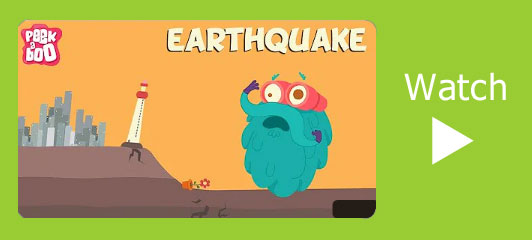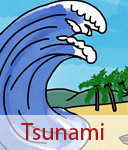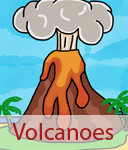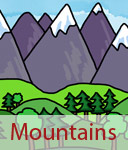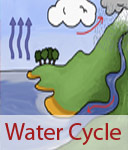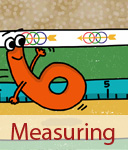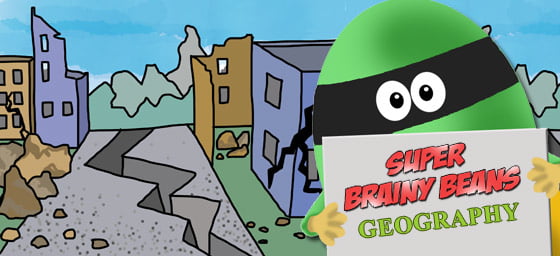
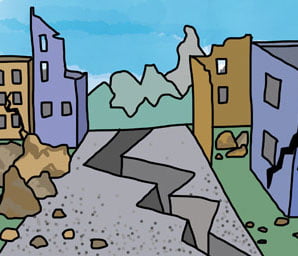
Earthquake facts
for kids
Earthquakes facts for kids learning in KS2 at Primary School. Homework help with the what an earthquake is and how they happen. Read about the impact of earthquakes on the environment.
What is an earthquake?
An earthquake is a release of energy in the earth that makes the ground tremble.
 BBC Bitesize: Earthquakes
BBC Bitesize: EarthquakesEarthquakes are events where the ground shakes. Learn now they start by watching a video and taking the quiz.
How do earthquakes happen?
Earthquakes happen when two tectonic plates move past each other in the earth's crust. As the plates move, the rock gets stretched or squeezed until it splits. This squeezing and stretching are what causes the ground to tremble and move.
When the rock gets jammed, the pressure builds up until it suddenly becomes free and this causes a huge release in energy and a big movement in the earth. The area underground where the rock moves is the start of the earthquake. We call the point on the surface directly above that the epicentre.
Sometimes not all of the energy is released in one go and the remaining energy is released a little while later. These bursts of energy are called aftershocks.
Earthquake facts
- The earthquake with the highest death toll of 830,000 was in central China in 1556.
- The deepest recorded earthquake, magnitude 8.3 was 609km below the ocean floor off of Russia's Kamchatka Peninsula in May 2013.
- Naqsha Bibi is the longest survivor of 63 days under the rubble, from an earthquake in Pakistan 2004. She ate rotting food and water that trickled through the rubble.
- The longest earthquake lasted 10mins in Sumatra in 2004.
 KD Find out!
KD Find out!Earthquakes are events where the ground shakes. Find out more facts.
 Weather WizKids
Weather WizKidsA tsunami is a large ocean wave usually caused by an underwater earthquake or a volcanic explosion.
Where do earthquakes occur?
Earthquakes mostly happen when two tectonic plates move past each other which means earthquakes are found on the edge of the world's tectonic plates. The Ring of Fire is the edge of the tectonic plate that the Pacific Ocean sits on. A lot of activity is found around the edge of this plate. About 90% of all earthquakes occur along this edge and 75% of all active volcanoes are found here too.
Research into mapping the most dangerous earthquake locations has found that there are 15 countries that are the most at risk. Japan, China, the Philippines, Iran and Indonesia are among the 15 most dangerous locations for earthquakes.
 Earthquake Track
Earthquake TrackSee where today's biggest earthquakes are with this live map.
How are earthquakes measured?
Earthquakes are measured using a seismometer which detects vibrations in the earth. The earthquake's size and strength are then measured using the Richter scale. Earthquakes can last anywhere between a few seconds for the smaller ones to a few minutes for the larger ones.
It is impossible to predict earthquakes. Seismometers only detect earthquakes when they are happening. However, after an earthquake, there are aftershocks (a series of smaller earthquakes). This is the only time when warnings can be given out to populated areas.
Scientists can make earthquake predictions. This is an estimate of where and when earthquakes might occur looking at previous data. One example is in California and the San Andreas fault line. Experts predict that there will be a destructive earthquake here in the next 30 years. This is because the two plates are moving at a rate of 30mm and 50mm a year. This may not seem much but the Pacific plate is moving faster and pressure is building under the earth's surface. The last time it had pressure like this was in 1906 when an earthquake with a magnitude of 7.8 hit. This is what makes scientists believe that there is another earthquake due soon.
Richter scale
| Richter Scale | Description | Frequency (per year) |
|---|---|---|
| 0 | Not felt by people | 800,000 |
| 1 | Plates and windows start to rattle | |
| 2 | Small objects move, liquid in glasses move around | |
| 3 | Ceiling lights swing, books fall off shelves | |
| 4 | Walls crack | 30,000 |
| 5 | Furniture moves | 1,400 |
| 6 | Some weaker buildings collapse | 100 |
| 7 | Many buildings destroyed | 15 |
| 8 | Total destruction of buildings, bridges and roads over several hundred miles | 1 every 5-10 years |
| 9 | Devastation in areas over thousands of miles | |
| 10 | Never recorded |
What impact does earthquakes have?
The obvious things that earthquakes cause are injury or death to people and animals. In addition, homes are destroyed, transport and communication become cut off and water and power lines may be affected too with the devastation that earthquakes bring. Broken gas pipes would cause explosions and fires often then spread.
High death tolls are often caused by a lack of preparation for earthquakes. This can include buildings not built to withstand the shake of the earthquake. Badly built structures are more likely to collapse and cause a huge number of deaths.
The huge amount of destruction that earthquakes can cost billions to repair. Entire communities often have to be rebuilt. Many businesses are often destroyed because of this. There is often a huge loss of income for many people.
With so many homes destroyed, many people are left homeless. Food and clean water may be hard to come by and therefore diseases spread. The devastation causes people to loot (when people steal from homes and businesses) as they are desperate to find supplies where there is a shortage.
 Stop Disasters Game
Stop Disasters GameLearn the risks posed by natural hazards and manage your resources. Build schools, hospitals, housing and defences to protect the local population.
Major Earthquakes
A major earthquake is any earthquake that measures a magnitude of 7.0 or above. Every year there are around fifteen major earthquakes that are recorded. Almost all of the major earthquakes occur at plate boundaries. The reason why we don't hear about all major earthquakes is that some occur in areas with little or no population. In populated areas, approximately 20,000 people die every year because of earthquakes. Below is a list of the major earthquakes in order of magnitude. These are significant earthquakes due to their location and devastation.
Most recent
1) Chile, May 1960 - Magnitude 9.5 highest ever recorded - 1,655 killed, 3,000 killed, 2,000,000 homeless
2) Sumatra, Indonesia, December 2004 - Magnitude 9.1 + Tsunami longest recorded at 10mins - 230,000 killed, 1,300,000 affected
3) Japan, March 2011 - Magnitude 9.0 + Tsunami - 15,690 killed, 17,000 missing, 125,000 damaged buildings, 500,000 homeless
4) Maule, Chile, February 2010 - Magnitude 8.8 - 521 killed, 370,000 buildings destroyed
5) Chincha Alta, Peru, August 2007 - Magnitude 8.0 + Tsunami - 519 killed, 1,300 injured 13,585 buildings destroyed
6) Sichuan, China, May 2008 - Magnitude 7.9 - 69,000 killed, 5,000,000 homeless
7) Turkey, February 2023 - Magnitude 7.8 - 52,000 killed, 200,089 buildings destroyed, 2,400,000 homeless
8) India, January 2001 - Magnitude 7.7 - 20,000 killed, 167,000 injured, 600,000 homeless
9) Pakistan, October 2005 - Magnitude 7.6 - 80,000 killed, 23,000 buildings destroyed
10) Indonesia, September 2018 - Magnitude 7.5 + Tsunami - 4,300 killed, 68,000 buildings destroyed
11) Iran, November 2017 - Magnitude 7.3 - 400 killed
12) Haiti, August 2021 - Magnitude 7.2 - 2,200 killed, 13,000 buildings destroyed
12) Port-au-Prince, Haiti, January 2010 - Magnitude 7.0 + Tsunami - 316,000 killed, 80,000 buildings destroyed
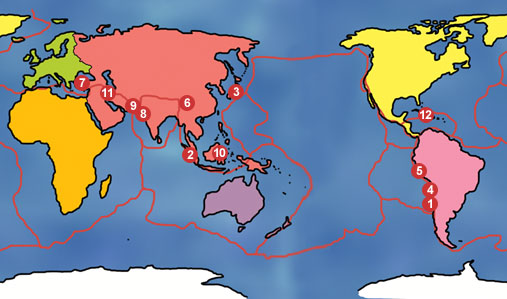
 Disaster Master
Disaster MasterHelp the Heroes in a disaster. Tornados, earthquakes, tsunamis and more.
 Natural History Museum - London
Natural History Museum - LondonVisit the 'Red Zone' to see close up what earthquakes do and the devastation it leaves behind.

